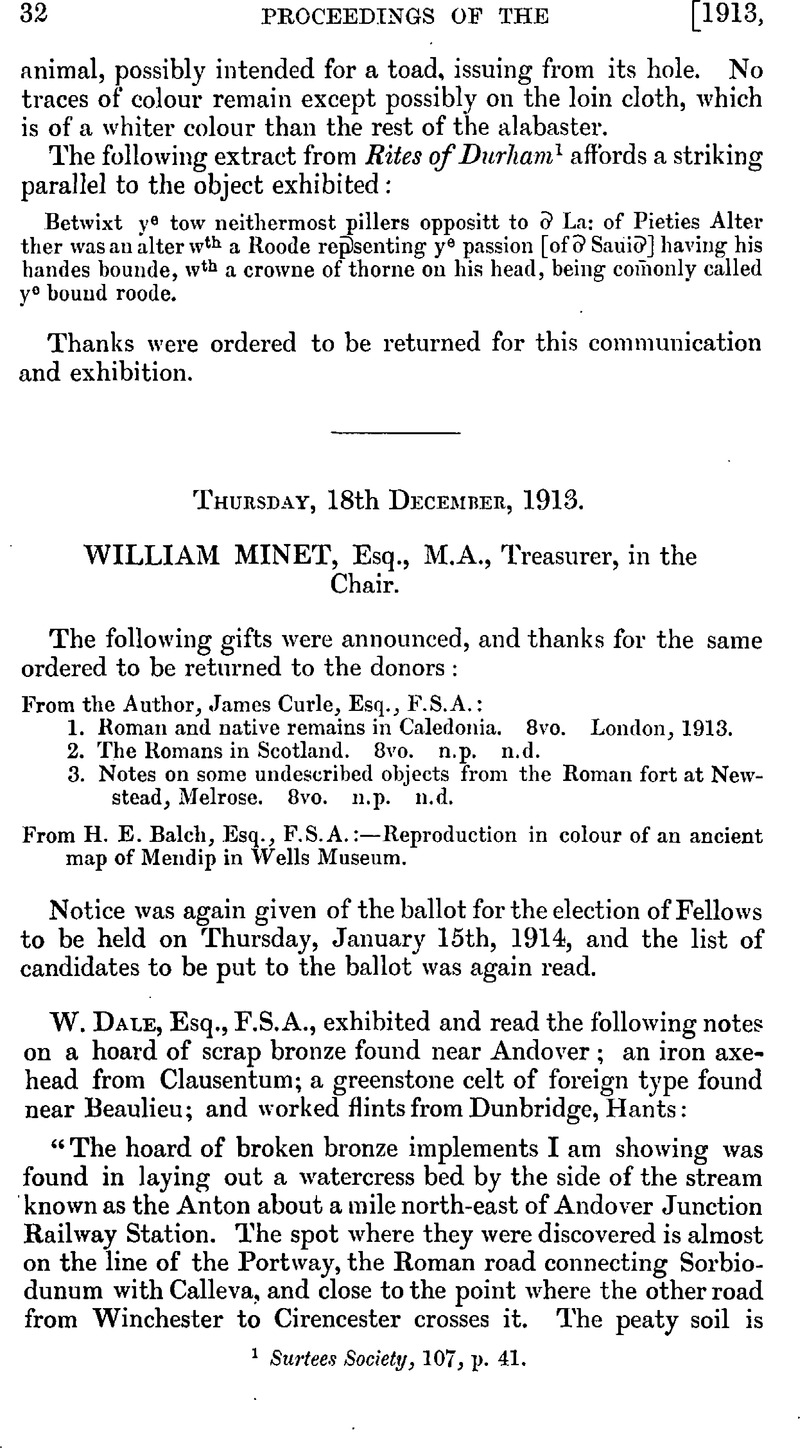No CrossRef data available.
Published online by Cambridge University Press: 10 May 2010

page 34 note 1 Canon Greenwell and Mr. Parker Brewis discussed this point in Archaeologia, lxi, pp. 452, 465. Chapes and cylindrical ferrules are illustrated in the paper.
page 35 note 1 Proceedings, xxiii, 169; L'Anthropologie, xiv, 513 ; xi, 523.
page 35 note 2 Revue de l'École d'Anthropologie de Paris, 1910, 22 (piquage).
page 35 note 3 Subsequent comparison with those in the Silchester hoard of tools (Archaeologia, liv, 147) makes the latter date more probable.
page 36 note 1 I take this opportunity of mentioning some late tallies which I have not described before. I have been indebted to the kindness of the officials of both the London Museum and the Guildhall Museum while making an inspection of these specimens. The London Museum tallies consist of four of the date 1706 and two later ones; perhaps the most interesting point about the four is the preservation along with them of three documents touching the assignment of the moneys involved, which were loans to the Treasury : it is perhaps well to emphasize the fact that all are Exchequer tallies (stocks) of the normal type. The Guildhall specimens, one of which is 3 ft. 8 in. in length and has a dent for a halfpenny, are all of the nineteenth century ; here again a special interest comes in, three of them relating to the repayment by the City of loans made to it by the Treasury for public works. I have been reminded that I never described in detail the large nineteenth-century tallies in the Public Record Office Museum and elsewhere in that Office. I took them to be sufficiently well known ; and, indeed, they (and other nineteenth-century tallies) have as a rule little of interest about them from the point of view of the history of the tally and its place in administration, except as illustrating the unwieldy length to which this instrument grew and the consequent difficulty experienced by those who tried (without medieval specimens before them) to interpret the passage in the Dialogus. Late tallies should always be readily traceable in other Records.
page 38 note 1 Its reference is now Exchequer Accounts, 482, 22.
page 40 note 1 Archaeologia, lxii, 367.
page 40 note 2 There is, of course, nothing to prevent the preservation of private tallies in this way, and an examination of the printed List of Exchequer Accounts will supply a certain number of instances of the occurrence. I am indebted to Mr. R. J. Whitwell for calling my attention to some good examples, among them that which is the subject of the present paper. One such is interesting as occurring in the Class of Ministers' Accounts (M.A. 1122, 15). Another (Exch. Accounts, 261, 21) is remarkable for giving us no less than twenty-seven tallies, some of them stocks and some foils, according to the position of the accountant in question in the transaction which originally produced them. It is worth observing, also, that some of them, whose notches deal with amounts of metal, add a note explanatory of the amount in cash ; further, that an examination of private tallies in any quantity seems to point to the contra form of words being the most common ; i.e. the private tally witnesses chiefly against the person who has received, the Exchequer tally in favour of the person who has paid : a slight indication of the relative importance of receiver and payer in the two cases. Nearness of the person concerned to official life and, consequently, of the tally to the Exchequer convention may naturally be expected in most of the specimens found thus attached to Exchequer Accounts.
page 41 note 1 It has siuce been acquired by the Victoria and Albert Museum.
page 41 note 2 Proceedings, vol. xxiii, p. 49.
page 41 note 3 See p. 4, supra.
page 43 note 1 Arch. Journ., vol. xliii, pp. 137 and 364.
page 43 note 2 Ibid., vol. lxi, p. 184.
page 44 note 1 J. E. Nightingale, The Church Plate of the County of Wilts., p. 180.